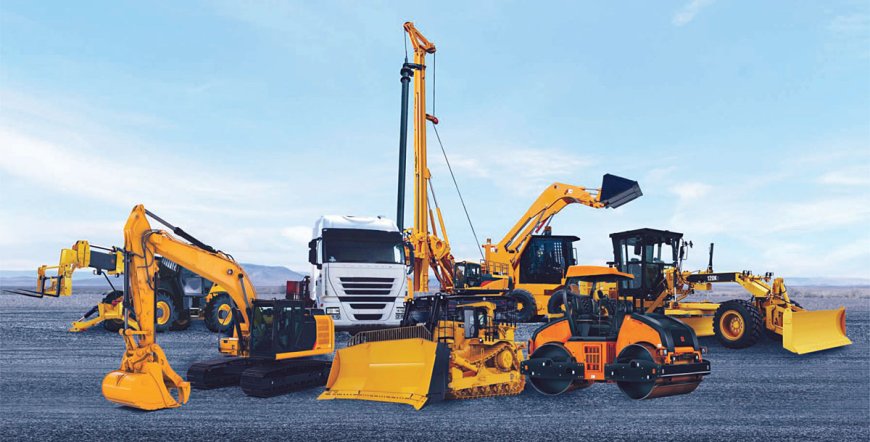INDIAN Manufacturing FACILITIES of CE Manufacturers
With considerable push both from the ever-rising infrastructure development in the country and the government of India led initiatives such as ‘Make in India’, the construction equipment manufacturers have been on a constant augmentation mode.

With considerable push both from the ever-rising infrastructure development in the country and the government of India led initiatives such as ‘Make in India’, the construction equipment manufacturers have been on a constant augmentation mode.
India, a country that had an underperforming infrastructure a few years back, has recently realized that the key to the economy’s good health is a vibrant infrastructure comprising both buildings and transport. A well-developed transport system that enables fast-tracking of the supply chain & logistics while efficient building infrastructure and supporting facilities such as pipelines and electricity are a necessity for a better standard of living. Thus, with the country’s vision to reach a USD5 trillion economy by 2025, the development of infrastructure has taken a front seat on the list of priorities of the Government of India, with a huge influx of investments in the form of various schemes and initiatives, such as the Smart Cities Mission aiming at transforming over 100 Indian urban centers into smart cities, the Jal Shakti Yojana with a vision to transit into efficient water management and many other such initiatives.
The biggest steppingstone in this direction is the government-led ‘National Infrastructure Pipeline (NIP) (FY2019-2025)’ scheme with a total outlay of USD1783.19 billion, covering multiple sectors such as roads & bridges, ports, urban public transport, airports, and railways, among many more. Another scheme, essentially a digital platform, launched by the Prime Minister of India, namely, PM Gati Shakti, envisions integrated planning and implementation of various infrastructure connectivity projects such as Sagarmala, Bharatmala, inland waterways, the UDAN scheme for the augmentation of aviation infrastructure in the country, etc. With the government’s aggressive push to drive the country’s economy through infrastructure, the Indian Construction Industry, which had been in a very nascent stage over 15 years back, is anticipated to rank third globally by 2025, with a market size of USD1 trillion. The industry has also been the second highest FDI (Foreign Direct Investment) recipient in FY 2020-21.
Number of Opportunities Segmented By Sector (National Infrastructure Pipeline)
However, all such plans and initiatives seem ambitious without the essential construction equipment, which, as per the Indian construction industry estimates, holds about 20-25% of the total cost of a large infrastructure development project. Therefore, the robust infrastructure development in the country and all the prospects have acted as the direct propellers of the India Construction Equipment Market, which possesses a market size of USD6.5 billion, positioning India at the third spot globally. The sales volume of the construction equipment in India has also showcased an upward trend, with a 14% degrowth in FY19-20 due to a slowdown in the sector. Though, the sales show recovery with sales of over 92 thousand units sold in FY2020-21 despite the pandemic, due to the ongoing construction activities in the country.
Construction Equipment Sales Volume (In Thousand Units)
Capturing export opportunities, especially to South-East Asian Countries, has also been an integral part of the manufacturers’ growth plans. Additionally, the ‘India Construction Equipment Manufacturers’ Association (ICEMA)’envisions to raise the bar for the India Construction Equipment Market by attaining the 2nd position globally, targeting a market size of USD25 billion and annual sales volume of 26 million units by 2030.
The India Construction Equipment Market, which was merely based on over-priced imports until the 1960s, has had a tremendous evolution over the tenure of 50 years, with companies like Bharat Earthmovers Ltd. (BEML) and Hindustan Motors’ Earthmoving Equipment Division (taken over by Caterpillar) being the earliest to begin construction equipment manufacturing operations in India. Ever since, the market has been christened by numerous medium to large-sized market players, the majority of them being international players who have either started manufacturing operations through joint ventures or have solely financed opening their manufacturing setups in the country, foreseeing huge protentional within the Indian sub-continent. Manufacturing rather than importing has been profoundly encouraged in India as the imported construction equipment failed to match the requirements and the conditions of Indian demographics, projects, and norms.
Fast forward to current times, the Construction Equipment Market of India is now home to over 50+ Original Equipment Manufacturers, including various big names such as Caterpillar, Komatsu, Volvo, Hitachi, BEML, Case, Mahindra, John Deere, JCB, Poclain, Greaves Cotton, Kobelco, Hyundai, Daewoo among many. The manufactured equipment comprises a mix of earthmoving equipment, road construction equipment, concrete equipment, material handling equipment & material processing equipment.
Percentage Breakup of Sales Segmented By Equipment Type, 2019
Construction equipment is a capital-intensive industry, requiring robust manufacturing infrastructure setups. The companies in the India Construction Equipment Market are, for a large share, organized with well-established systems, assemblies, and hierarchies. Additionally, the established manufacturing infrastructure is attributable to the presence of internationally renowned market players in the country and the sophistication of technology it requires to manufacture construction equipment. For instance, JCB, a market leader in Construction Equipment Manufacturing in India, with backhoes being the bestselling equipment, has over five state-of-the-art manufacturing facilities across the country. Bharat Earthmovers Ltd. (BEML) also has a wide presence in terms of manufacturing across the nation with various test centers. With the companies possessing years of experience in manufacturing construction equipment, the manufacturers have come a long way to attain economies of scale, thus making it difficult for new entrants to penetrate the market.
With the market being provided a considerable push both from the ever-rising infrastructure development in the country and the government of India-led initiatives such as ‘Make In India,’ along with regimes such as ‘Vocal for Local’, the construction equipment manufacturers of the country have been on a constant augmentation mode in terms of sales volume, indigenization and process/operational improvement. The indigenization percentage in the Indian Construction Equipment ranges between 75% to 95%, encouraged by sentiments of Indian construction firms and contractors for using locally made equipment and for machines effective to work in Indian Conditions and newly laid emission norms CEV (Construction Equipment Vehicles) Stage III. For instance, caterpillar equipment follows 75% indigenization, while for JCB backhoes, indigenization is close to 95%.
India has joined hands with the other countries in adopting the Industry 4.0 strategy to revolutionize and automate the country’s various industries. Under the regime, the manufacturers in the India Construction Equipment Market have been a few of the earliest adopters of digitalization and the Internet of Things in their processes and equipment. From fully electric/automated vehicles to the use of telematics for monitoring and controlling the health of the equipment over its serviceable life, new technologies are being adopted by the market players. The Augmented Reality/Virtual Reality concept has also been used increasingly for prototyping the equipment conceptualized.
Supply Chain Management & Customer Management Systems have been in practice in the market by a majority of players in the India Construction Equipment Market. Sophisticated software such as ERP (Enterprise Resource Planning) and SAP are extensively used to streamline the market’s entire value chain.
Skilling development of manpower has also served as the core focus of the India Construction Equipment Market. This is because, with the infrastructure projects gaining momentum in the country and with the construction equipment getting more complex and sophisticated with the adoption of the latest technologies, the market has been dealing with a shortage of manpower. In order to fill the vulnerable gap between supply and demand of manpower, both the companies in the Construction Equipment Market and the Infrastructure Equipment Skill Council (IESC) have been consistently working towards upskilling and training manpower in terms of equipment operations and mechanics. The companies have been conducting apprenticeship and training programs, later absorbing the trained personnel as their staff. IESC has been associated with the Ministry of Skill Development to upskill personnel in the India Construction Equipment Market.
India, as a developing nation, is at a phase when it is ready to take strides in terms of growth and development. With the manufacturers in the India Construction Equipment Market diligently working towards excelling in manufacturing and process improvement, the market can substantially contribute to making the country a USD5 trillion economy, as envisioned by the government of India.
Hits: 8








